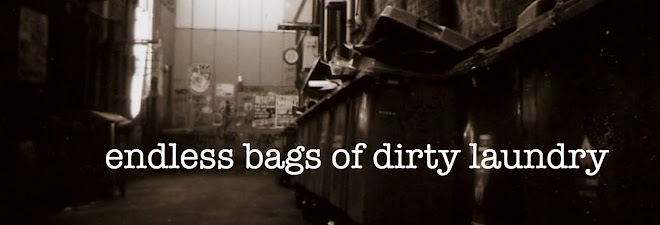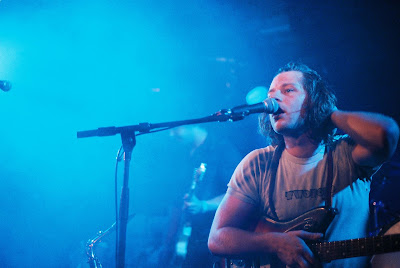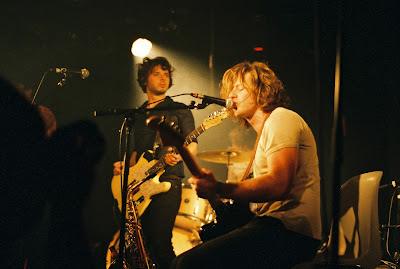I'm
sure there are other, more insightful similarities between the two gigs
I saw and photographed last week, but in my mind and memory, there is
one thing that unites them above all else: sweat. I'm not just talking a
bit of upper-lip moisture, either. I'm talking about drenching my
shirt, stinging my eyes, trickling down the back of my neck, threatening
to drown my camera every time I looked through the viewfinder. I
actually didn't realise I was capable of producing that much sweat.
Twice in one week.
Both
shows occurred during Melbourne's March heatwave, both were in venues
that are notoriously warm when things get busy, and both were at
capacity. The first was Saskwatch returning to Cherry for the first show
of their March residency (above). The second was Royal
Headache playing a wonderfully intimate show at the John Curtin Hotel
(top).


I've
been using the grainy black and white a lot for live stuff lately, and
to be honest I think it's my go-to for this kind of thing. In large
part, that's because it's the most capable film I know for low-light
situations, but I also love it because it's different from most other
black and white live stuff you see around the place. In the first guitar
shot here (Royal Headache), it's kind of washed out and grey, and in
the second (Saskwatch) it's got a lot more contrast. Usually I always
prefer high contrast, but sometimes it's nice to have some variety, and
there is something charming about the greyer image; again, the almost
faded grainy look is just very different from most stuff I see, which is a positive .




I
only used black and white for Royal Headache, but for Saskwatch at
Cherry I decided to embrace the red curtain and shoot some slide as
well. The way I shot and processed it really brings out extreme contrast
and extra red, which again, makes them quite different from a lot of
live stuff out there. Don't get me wrong - I am not against
'regular'-looking film, but with a type of photography (live music) that
so often looks the same, it's important for me to experiment
with how I can bring something new to the images. The intense
contrast+red in these shots isn't my favourite effect in the world, but I
do think it has potential, and in the second photo of these four, I
think the lighting and contrast works beautifully, especially on Nic's
face (centre).



As with the black and whites above, the first two photos here show how the
same film and shooting conditions can produce pretty different results.
The first of the two is really high contrast, while the second is a lot
less intense, and red almost looks faded. I think in this case, I like
the second, faded look better. Having said that, LOOK AT THE THIRD ONE!
What an incredible image to have shot and not photoshopped or anything -
just to have the red of the curtain and the red of the stage lights and
the film producing this intense two-tone effect. I love this.

I
just want to take a moment to celebrate this really animated image of
the horn section. They're usually tucked away behind their very large
and obscuring mic stands, so it's difficult to get a dynamic image
of all of them. At this moment, they came out to the centre of the stage
during their cover of Robbie Williams' 'Kids', and encouraged the
audience to sing the refrain. It's particularly appealing to me because
they're all active: Liam and Will are singing, Nic is wiping the sweat
off his face, and Sam is encouraging the crowd to sing it loud. Great.



In
my ongoing attempt to get something slightly left of centre, I often
try to get in close and focus on small details that still capture the
energy or some other essential part of the performance. Olaf's
keys-playing is a good example, and works well here because you can see
Rob's guitar in the background so the shot's a bit more dynamic. But
really, the stars here are the ones of Nkechi. She's such an incredible
photography subject when she's on stage, because the way she moves and
the way she physically sings are mesmerising. If it weren't for all the
dancing this band commands of its audience, I'm quite sure people would
just be transfixed on Nkech the entire time. These images of her arm and her hand on the
mic stand here are just two examples of getting in close to capture
elements of her physical performance. I'd love to do this more with her,
because by God, there are a lot of things to capture.



Royal Headache's lead singer, Shogun, is mesmerising in an
entirely different way. He alternates between pacing frenetically across
the stage and pausing to crouch and focus on singing intensely and
beautifully. I was right up the front for this gig, which was great for
shooting, but not great for my physical well-being; Shogun's freneticism is nothing
compared to the brutal energy of Royal Headache's die-hard fans, who
evidently love to shove, stage dive, crowd surf and smash shit. But I
was tough! I was going to get my shots! A kick to the head, a stranger
falling onto my lap and a million little bruises all over me weren't
going to deter me! And my persistence paid off; apparently Shogun wasn't
so sure of my physical capabilities and eventually insisted that I get
onto the stage to shoot in order to be a bit safer.





I
think this selection captures the energy in the room quite well. The
square shots were taken on my Holga, using a flash - which I don't
ordinarily do for fear of annoying people but I don't think any of these
people even noticed it; with all that activity a flash of light is the
last thing on their minds.
These
capture the more subdued moments in the set, where the energy relaxed
momentarily in anticipation of the next adrenaline surge. I feel really
lucky that I was close enough to photograph Shogun like this; it's rare
in any live situation to be literally face to face with a performer. In
this case he knelt right in front of me to sing a little. Just perfect.
I
wasn't sure about this one when I first saw it, but actually I really
love it. The focus is on the guy in the audience, who is sweaty and
looks exhausted, but also looks like he's loving it. Then you see the
blur that is Shogun, and the movement implicit in that blur betrays the
energy of the performance, giving us some idea of why the dude in the
crowd may be so sweaty and satisfyingly exhausted. It just works really
well for me.
These
are just a few more I had to include. Like I think I've made clear
above, they're basically an awesome band to watch and to shoot. I took a
lot of photos but I felt that I couldn't stop because if I did I'd miss
something amazing. These also represent a success story in terms of
shooting at the Curtin, because in the past I've found the lighting
really difficult. I think this film is the key. (Or shooting with a
flash in rare cases.)
Both of these shows were
incredible, and a privilege to shoot. Engaging performers, great
musicians, responsive crowds and all-round awesome music is a pretty
good combination for getting good shots, despite any technical obstacles
that can (and do) arise.
So what I'm saying, in conclusion, is this: the sweat, the bruises, the exhaustion - one hundred per cent worth it.














































































